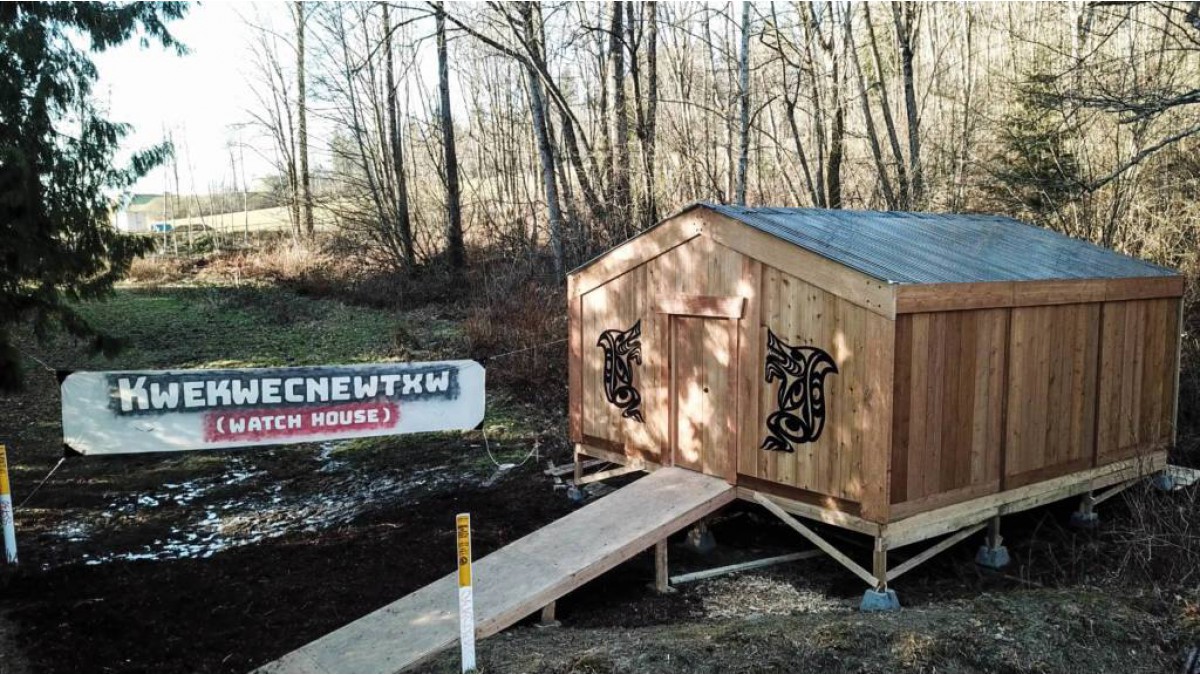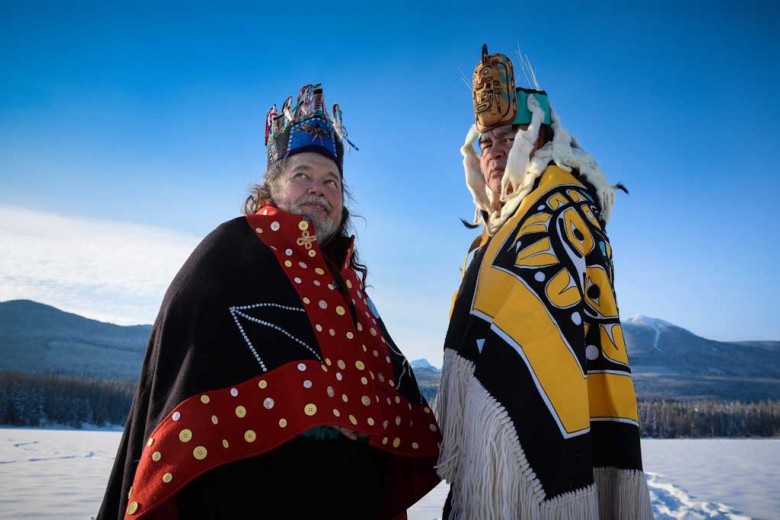The handful of supporters in the sparsely-populated courtroom came there to bear witness and stand in solidarity with an Indigenous Elder who had just been tried for a second time and was now awaiting the verdict.
In December, B.C. Supreme Court Justice Shelley Fitzpatrick found Jim Leyden guilty of criminal contempt of court for breaching an injunction originally brought by Trans Mountain Pipeline ULC (TMX) in March 2018. The injunction is the line that TMX has drawn in the sand, so as to stifle any meaningful resistance at the company’s worksites throughout the province – including TMX contractors and subcontractors – and all along the pipeline’s path.
It was Leyden’s second conviction, with more than 230 people found guilty of breaching the TMX injunction since 2018. Those in court to support Leyden on December 9, 2020, were unsurprised by the verdict, but they were nonetheless outraged. Leyden’s conviction represents a new strategy by TMX and the Crown that skirts established Crown policy on civil disobedience and ruthlessly targets Indigenous land defenders.
The injunction is the line that TMX has drawn in the sand, so as to stifle any meaningful resistance at the company’s worksites throughout the province.
Leyden, 68, was sentenced for his first conviction in October, along with his two Indigenous co-defendants – Stacy Gallagher, 58, and Tawahum Bige, 27 – all of whom were in ceremony at the time of their August 2018 arrests. Fitzpatrick all but ignored Leyden’s health conditions, which would normally mitigate his punishment, and sentenced him, along with Gallagher and Bige, to the Crown’s recommendation of 28 days in jail, one of the longest sentences imposed against land defenders for breaching the TMX injunction.
During COVID-19, these sentences amount to solitary confinement, much harsher than normal detention conditions. Leyden, who already suffers from pancreatitis and a heart condition, and has been in and out of hospitals since his 2018 arrest, spent much of the time between his release and his second trial in the hospital dealing with health and heart impacts from multiple spider bites he got while in jail at North Fraser Pretrial Centre.
Repressive precedents
On New Year’s Eve 2019, Leyden and Gallagher were served with notices from the Crown that they were being charged, yet again, with criminal contempt for apparent activity at TMX’s Burnaby Mountain facility (Burnaby Terminal) in November and December of that year. But no arrests had occurred at the scene, which left Leyden and Gallagher wondering why they were being charged.
After reviewing the disclosure, it became evident that Leyden and Gallagher were being targeted by TMX and the Crown. Affidavits and video footage taken by TMX security personnel identified Leyden and Gallagher near the gates of the Burnaby Terminal on December 2, 2019. Additional footage also showed Gallagher in the same general location on November 15 and December 18, 2019.
Notably, each video clip showed Leyden and Gallagher surrounded by several other, mostly white land defenders. But no one else was charged by the Crown.
It’s well known that Leyden and Gallagher are part of a group called the Mountain Protectors which, among other things, monitors TMX work carried out at the Burnaby Terminal. (I am also a member of the group.) The terminal is also known as the “tank farm,” because of the giant oil storage tanks spread out over the side of the mountain that can be seen from several kilometers away. With permission and direction from traditional Elders of the three host nations – Tsleil-Waututh, Squamish, and Musqueam – Leyden, Gallagher, and others have engaged in ceremony and carried out monitoring activities from an Indigenous Watch House built in March 2018, which sits adjacent to the tank farm and is explicitly excluded from the TMX injunction despite its position atop the pipeline route.
Notably, each video clip showed Leyden and Gallagher surrounded by several other, mostly white land defenders. But no one else was charged by the Crown.
According to the website of Protect the Inlet, a Watch House (“Kwekwecnewtxw” or “a place to watch from” in the henqeminem language) is “grounded in the culture and spirituality of the Coast Salish Peoples” and is a “traditional structure they have used for tens of thousands of years to watch for enemies on their territories and protect their communities from danger.”
On the same day that Leyden was accused for a second time of violating the injunction, he and others were attempting to bring light to claims that TMX was improperly transporting contaminated soil from the tank farm to an industrial park in Port Coquitlam. The Mountain Protectors issued a press release a day earlier questioning whether the company was in violation of provincial contaminated soil regulations. Leyden can be seen in his disclosure footage talking to people Fitzpatrick referred to during his trial as “media types.”
On two of the three days in 2019 for which Leyden and Gallagher were charged with criminal contempt, law enforcement was not even present. At no time were they asked by RMCP to leave the area, as defined in a “five step process” laid out in the injunction, ostensibly to avoid unnecessary arrests. In fact, a Crown Counsel Policy Manual from 2014 on Civil Disobedience and Contempt of Related Court Orders puts emphasis on the need to give protesters a “clear demand to leave” the premises, referred to in legal parlance as a “dispersal order.”
Latest trials of Indigenous land defenders engaged in ceremony
Gallagher and Leyden were scheduled to be tried together in August, but due to concerns that Leyden might have COVID-19, his trial was postponed. Gallagher’s trial, however, began as planned and lasted eight days. During the trial, Fitzpatrick’s disrespect for defence counsel was palpable and she consistently deferred to the whims of the Crown. The defence explained how Gallagher follows the Anishinaabe ways of his mother’s ancestors, his grandmothers’ teachings, and the natural laws. Gallagher testified and explained that he serves the people as a fire keeper and Opwaagan/pipe carrier, and by upholding his spiritual and ceremonial responsibilities. Gallagher told the court he was engaged in ceremony on the days in question, and pointed out that he was not asked to leave.
Fitzpatrick was dismissive of and showed contempt for the basic facts of Indigenous history. Her unexamined stereotypes and uninformed attitudes toward Indigenous Peoples, cultures, and values were on full display. These were some of the points made in a 93-page complaint against Fitzpatrick submitted to the Canadian Judicial Council on December 3, questioning her ability to be fair and impartial in these cases (a summary of the report can be found here).
Gallagher told the court he was engaged in ceremony on the days in question, and pointed out that he was not asked to leave.
Needless to say, on November 13, Fitzpatrick found Gallagher guilty of all three contempt charges. Gallagher is scheduled to be sentenced on January 25, 2021, and the Crown is recommending he serve an additional 90 days in jail.
Leyden’s second trial began on December 7 and lasted three days. He, too, testified on his own behalf. Leyden explained to the court that he comes from Six Nations territory in Ontario, was apprehended during the ’60s Scoop, and was relocated outside of his home territory for adoption. After moving to Coast Salish territory, Leyden became an Elder, senior Sundancer, and the head firekeeper for Sundance chief Robert Nahanee. Most recently, he was asked to carry out the role of watchman as a Watch House Elder, keeping an eye on the work being done at TMX and reporting misconduct to government agencies and the public.
Leyden also pointed out that no one asked him to leave. In fact, when police showed up on the scene, they took part in the ceremony led by Leyden, during which police were videotaped holding hands with those gathered near the entrance to the Burnaby Terminal and passing the pipe during that part of the ceremony. Leyden and others left the scene soon after, and none the wiser.
Before finding Leyden guilty of criminal contempt, Fitzpatrick told him the injunction provides for an “absolute prohibition” and does not require police to ask him to leave. Fitzpatrick claimed that the RCMP’s five step process in the injunction is merely discretionary, and that Leyden’s opposing arguments “fly in the face” of the terms of the injunction.
In fact, when police showed up on the scene, they took part in the ceremony led by Leyden, during which police were videotaped holding hands with those gathered near the entrance to the Burnaby Terminal and passing the pipe during that part of the ceremony.
Never mind that RCMP officers were careful to adhere to each step of the five step process when they arrested more than 230 mostly white people for symbolic civil disobedience at the gates of TMX in the spring and summer of 2018. In some cases, police pleaded with land defenders to leave so they didn’t have to arrest them. One exception occurred on March 19, 2018, when RCMP officers violently attacked several Indigenous land defenders before arresting them.
Leyden is scheduled to be sentenced on March 1, 2021, and the Crown is recommending he serve an additional 60 days in jail. “The Crown has made it clear that the increased severity of these sentences is meant to stifle resistance to the pipeline,” says Leyden. “They’re using us as an example to scare others from confronting Trans Mountain.”
Using injunction law to curb resistance and free expression
Injunctions have long been used in B.C. to stifle opposition to corporate and government agendas – limiting the effectiveness of striking workers, displacing homeless encampments, and suppressing resistance to harmful environmental projects like TMX and the Coastal GasLink pipeline.
Under the guise that breaching a court order “depreciates the authority of the court” and brings us to the brink of a lawless society, the B.C. Supreme Court uses injunctions – one of its favorite legal tools – to legitimize the repression of political resistance. In B.C., when one violates the terms of an injunction, the offence falls under the arcane English common law, which is based largely on the discretion of judges, cannot be found in Canada’s Criminal Code, and relies only on past decisions.
Under the guise that breaching a court order “depreciates the authority of the court” and brings us to the brink of a lawless society, the B.C. Supreme Court uses injunctions – one of its favorite legal tools – to legitimize the repression of political resistance.
A breach of the TMX injunction can occur in three ways: (1) obstruction of an entrance to a TMX facility, including facilities of TMX contractors and subcontractors, (2) destroying signage or fencing around TMX sites, or (3) coming within five metres of TMX property. A glaring hypocrisy of the TMX injunction is that a frequently used public trail on the south side of the Burnaby Terminal winds its way directly through the 5-metre zone, but only when land defenders or protesters dare to get too close to TMX property does the company, the RCMP, and the Crown take notice. Former B.C. Supreme Court Justice Kenneth Affleck, who granted the 2018 TMX injunction, consistently denied that the order violated anyone’s Charter rights to free expression and repeatedly made reference to the injunction’s abstract claim that people “remain at liberty to engage in peaceful, lawful and safe protest” as he found defendant after defendant guilty of contempt.
The most recent verdicts from Fitzpatrick set a chilling precedent on how the Crown can handle these contempt cases, without even the presence of police or an order to disperse. Apparently, all it takes to be charged, brought into the B.C. Supreme Court, and forced to endure a near-certain conviction (only one acquittal has occurred from more than 230 prosecutions) is for TMX to videotape people near or on company property and then request to bring criminal contempt charges.
The most recent verdicts from Fitzpatrick set a chilling precedent on how the Crown can handle these contempt cases, without even the presence of police or an order to disperse.
In case it needs to be spelled out, the B.C. government – in the robes of Crown Counsel – is working at the behest of TMX. There is no veil hiding the relationship between the Court, the Crown, and corporations like Trans Mountain, whether they’re owned by Texas-based Kinder Morgan or the Canadian government.
As if that wasn’t sufficient to stifle TMX resistance, the Crown recommended – and Fitzpatrick gladly ordered – that Leyden and Gallagher be prohibited from coming within 500 metres of TMX facilities as a bail condition for their most recent charges. Setting aside unaddressed land rights issues and the federal government’s arrogant disregard of Indigenous opposition to the pipeline, how is a one-half kilometer “stay-away zone” not a violation of one’s Charter rights to free expression, whether one is Indigenous or a settler?
“The 500-metre stay away order has greatly impacted our ability to monitor Trans Mountain work sites so that we can hold them accountable,” says Leyden. “And I believe that was their intent.”
Reasons mount to abandon troubled TMX project
While Leyden, Gallagher, and Bige were serving their jail sentences in October, several people – including a Secwepemc Hereditary Chief and his daughter – were arrested for allegedly breaching the TMX injunction near Kamloops in Secwepemc territory. The company had begun drilling under the North Thompson River during the salmon run and people were rightly outraged.
Rather than genuinely address opposition to the pipeline expansion project, the ongoing arrests are attempts by the federal and provincial governments to prosecute and jail their way out of the problem. Eight of these land defenders will have their first appearance on contempt charges in the B.C. Supreme Court on January 20.
Ever since the Canadian government bought TMX from Texas oil giant Kinder Morgan for $4.5 billion in 2018, costs associated with building the pipeline have risen steadily to more than $12 billion while oil prices have fallen precipitously. The federal government has not only fought legal challenges from the Squamish and Tsleil-Waututh Nations and the Coldwater Indian Band in order to avoid meaningful consultation and having to seek widespread Indigenous approval; Canada is also driving at top speed in the opposite direction of meeting its commitments in the Paris Climate Agreement.
“The 500-metre stay away order has greatly impacted our ability to monitor Trans Mountain work sites so that we can hold them accountable,” says Leyden. “And I believe that was their intent.”
The existing Trans Mountain pipeline is already an environmental and public health hazard with a long history of disastrous spills. As recently as June, 50 thousand gallons of crude oil spilled from a pump station located above an aquifer that supplies the Sumas First Nation with drinking water. The TMX project would impact numerous drinking water sources along the route and lead to a seven-fold increase in tanker traffic in the Burrard Inlet, threatening the endangered southern resident orcas. Because of the known seismic, fire, and chemical hazards associated with the tank farm, hundreds of thousands of residents in the “evacuation zone” will be put at grave risk, not to mention the tens of thousands of students and staff at Simon Fraser University and Burnaby Mountain Secondary School.
Even internal health and safety issues are plaguing the company. On December 15, a worker at the TMX Westridge Terminal in Burnaby was hospitalized after being seriously injured, causing TMX to suspend all construction operations in the Lower Mainland. The accident follows revelations that the Canada Energy Regulator recently found “systemic non-compliances” of COVID-19 mask rules at worksites across the Lower Mainland.
Irreparable harm?
Leyden and Gallagher are committed to appealing their convictions, but it’s unclear how far the RCMP, the Crown, and the courts are prepared to go in serving the interests of TMX.
“The treatment and experience of my client in the B.C. Supreme Court is a reflection of how much work there is still to do,” says Michelle Silongan of ST Law and the Law Union of B.C., who is representing Leyden in one of his appeals. “Reconciliation requires that the Canadian legal system affirm the laws, protocols, and traditions that Indigenous people have practiced here since time immemorial. Without recognizing and paying heed to the foremost obligations and responsibilities held by Indigenous defendants, both reconciliation and justice will remain elusive.”
“They’re using us as an example to scare others from confronting Trans Mountain.”
Antiquated colonial laws are being wielded like a stick over the heads of climate activists and Indigenous land defenders, with no clear end game. Will the Crown be able to continue targeting Indigenous land defenders with impunity? How far will the courts go to repress and punish those opposed to a pipeline expansion project that seems doomed to fail?
TMX relied on questionable evidence of “irreparable harm” in order to impose an injunction and attempt to shield itself from opposition, but the impact to Indigenous Peoples and settlers alike, and the certain environmental devastation for generations to come, is the harm we should be addressing.







